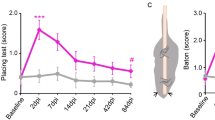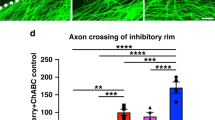Abstract
The arrest of dorsal root axonal regeneration at the transitional zone between the peripheral and central nervous system has been repeatedly described since the early twentieth century1. Here we show that, with trophic support to damaged sensory axons, this regenerative barrier is surmountable. In adult rats with injured dorsal roots, treatment with nerve growth factor (NGF), neurotrophin-3 (NT3) and glial-cell-line-derived neurotrophic factor (GDNF), but not brain-derived neurotrophic factor (BDNF), resulted in selective regrowth of damaged axons across the dorsal root entry zone and into the spinal cord. Dorsal horn neurons were found to be synaptically driven by peripheral nerve stimulation in rats treated with NGF, NT3 and GDNF, demonstrating functional reconnection. In behavioural studies, rats treated with NGF and GDNF recovered sensitivity to noxious heat and pressure. The observed effects of neurotrophic factors corresponded to their known actions on distinct subpopulations of sensory neurons. Neurotrophic factor treatment may thus serve as a viable treatment in promoting recovery from root avulsion injuries.
This is a preview of subscription content, access via your institution
Access options
Subscribe to this journal
Receive 51 print issues and online access
$199.00 per year
only $3.90 per issue
Buy this article
- Purchase on Springer Link
- Instant access to full article PDF
Prices may be subject to local taxes which are calculated during checkout




Similar content being viewed by others
References
Ramon y Cajal, S. Degeneration and Regeneration in the Nervous System (Hafner, New York, 1928).
Bennett, D. L. H. et al. A distinct subgroup of small DRG cells express GDNF receptor components and GDNF is protective for these neurons following nerve injury. J. Neurosci. 18, 3059– 3072 (1998).
Averill, S., McMahon, S. B., Clary, D. O., Reichardt, L. F. & Priestley, J. V. Immunocytochemical localization of trkA receptors in chemically identified subgroups of adult rat sensory neurons. Eur. J. Neurosci. 7, 1484– 1494 (1995).
Bradbury, E. J., Burnstock, G. & McMahon, S. B. The expression of P2X3 purinoceptors in sensory neurons: effects of axotomy and glial-derived neurotrophic factor. Mol. Cell. Neurosci. 12, 256– 268 (1998).
McMahon, S. B., Armanini, M. P., Ling, L. H. & Phillips, H. S. Expression and coexpression of Trk receptors in subpopulations of adult primary sensory neurons projecting to identified peripheral targets. Neuron 12, 1161–1171 ( 1994).
Chong, M. S., Woolf, C. J., Haque, N. S. & Anderson, P. N. Axonal regeneration from injured dorsal roots into the spinal cord of adult rats. J. Comp. Neurol. 410, 42– 54 (1999).
Kozlova, E. N., Stromberg, I., Bygdeman, M. & Aldskogius, H. Peripherally grafted human foetal dorsal root ganglion cells extend axons into the spinal cord of adult host rats by circumventing dorsal root entry zone astrocytes. Neuroreport 6, 269– 272 (1995).
Thompson, S. W. N., Dray, A., McCarson, K. E., Krause, J. E. & Urban, L. Nerve growth factor induces mechanical allodynia associated with novel A fibre-evoked spinal reflex activity and enhanced neurokinin-1 receptor activation in the rat. Pain 62, 219–231 (1995).
Houle, J. D., Skinner, R. D., Garcia-Rill, E. & Turner, K. L. Synaptic evoked potentials from regenerating dorsal root axons within fetal spinal cord tissue transplants. Exp. Neurol. 139, 278–290 (1996).
Oudega, M. & Hagg, T. Neurotrophins promote regeneration of sensory axons in the adult rat spinal cord. Brain Res. 818, 431–438 (1999).
Itoh, Y. & Tessler, A. Regeneration of adult dorsal root axons into transplants of fetal spinal cord and brain: a comparison of growth and synapse formation in appropriate and inappropriate targets. J. Comp. Neurol. 302, 272–293 (1990).
Tessler, A., Himes, B. T., Houle, J. D. & Reier, P. J. Regeneration of adult dorsal root axons into transplants of embryonic spinal cord. J. Comp. Neurol. 270, 537– 548 (1988).
Rosario, C. M., Aldskogius, H., Carlstedt, T. & Sidman, R. L. Centrifugal growth in orthotopic grafts of allogenic dorsal root ganglia of adult rats: evidence for possible central ingrowth. Exp. Neurol. 115, 158–162 ( 1992).
Ramon-Cueto, A. & Nieto-Sampedro, M. Regeneration into the spinal cord of transected dorsal root axons is promoted by ensheathing glia transplants. Exp. Neurol. 127, 232– 244 (1994).
Sims, T. J. & Gilmore, S. A. Regeneration of dorsal root axons into experimentally altered glial environments in the rat spinal cord. Exp. Brain Res. 99, 25–33 (1994).
Zhang, Y., Dijkhuizen, P. A., Anderson, P. N., Lieberman, A. R. & Verhaagen, J. NT-3 delivered by an adenoviral vector induces injured dorsal root axons to regenerate into the spinal cord of adult rats. J. Neurosci. Res. 15 , 554–562 (1998).
Neumann, S. & Woolf, C. J. Regeneration of dorsal column fibres into and beyond the lesion site following adult spinal cord injury. Neuron 23, 83–91 ( 1999).
Iwaya, K., Mizoi, K., Tessler, A. & Itoh, Y. Neurotrophic agents in fibrin glue mediate adult dorsal root regeneration into spinal cord. Neurosurgery 44, 589–596 (1999).
Cai, D., Shen, Y., DeBellard, M. E., Tang, S. & Filbin, M. T. Prior exposure to neurotrophins blocks inhibition of axonal regeneration by MAG and myelin via a cAMP-dependent mechanism. Neuron 22, 89– 101 (1999).
Schnell, L., Schneider, R., Kolbeck, R., Barde, Y. A. & Schwab, M. E. Neurotrophin-3 enhances sprouting of corticospinal tract during development and after adult spinal cord lesion. Nature 367, 170–173 (1994).
Dyer, J. K., Bourke, J. A. & Steeves, J. D. Regeneration of brainstem-spinal axons after lesion and immunological disruption of myelin in adult rat. Exp. Neurol. 154, 12–22 ( 1998).
Kalderon, N. & Fuks, Z. Structural recovery in lesioned adult mammalian spinal cord by x-irradiation of the lesion site. Proc. Natl Acad. Sci. USA 93, 11179–11184 (1996).
Davies, S. J. et al. Regeneration of adult axons in white matter tracts of the central nervous system. Nature 390, 680– 683 (1997).
Bradbury, E. J., Khemani, S., King, V. R., Priestley, J. V. & McMahon, S. B. NT-3 promotes growth of lesioned adult rat sensory neurons ascending in the dorsal columns of the spinal cord. Eur. J. Neurosci. 11, 3873–3883 (1999).
Zhou, X. F. et al. Satellite cell-derived nerve growth factor and neurotrophin-3 are involved in noradrenergic sprouting in the dorsal root ganglia following peripheral nerve injury in the rat. Eur. J. Neurosci. 11, 1711–1722 (1999).
Winkler, J. et al. Reversible Schwann cell hyperplasia and sprouting of sensory and sympathetic neurites after intraventricular administration of nerve growth factor. Ann. Neurol. 41, 82–93 ( 1997).
Fraher, J. P. The transitional zone and CNS regeneration. J. Anat. 194, 161–182 (1999).
Acknowledgements
We thank E. Bradbury and T. Boucher for critical review of the manuscript, V. Cheah for technical assistance, and D. Shelton and Q. Yan for supplying neurotrophic factors. This work was supported by the European Union (S.B.M and J.V.P.) and a Prideaux grant from the Special Trustees of St. Thomas’ Hospital (S.B.M). M.S.R. receives a fellowship from the Medical Research Council of Canada.
Author information
Authors and Affiliations
Corresponding author
Rights and permissions
About this article
Cite this article
Ramer, M., Priestley, J. & McMahon, S. Functional regeneration of sensory axons into the adult spinal cord. Nature 403, 312–316 (2000). https://doi.org/10.1038/35002084
Received:
Accepted:
Issue Date:
DOI: https://doi.org/10.1038/35002084
This article is cited by
-
Regulation of axonal regeneration after mammalian spinal cord injury
Nature Reviews Molecular Cell Biology (2023)
-
Can the administration of platelet lysates to the brain help treat neurological disorders?
Cellular and Molecular Life Sciences (2022)
-
FSD-C10, a Fasudil derivative, promotes neuroregeneration through indirect and direct mechanisms
Scientific Reports (2017)
-
Reorganization of Intact Descending Motor Circuits to Replace Lost Connections After Injury
Neurotherapeutics (2016)
-
Role of Nectin-1/c-Src Signaling in the Analgesic Effect of GDNF on a Rat Model of Chronic Constrictive Injury
Journal of Molecular Neuroscience (2016)
Comments
By submitting a comment you agree to abide by our Terms and Community Guidelines. If you find something abusive or that does not comply with our terms or guidelines please flag it as inappropriate.



